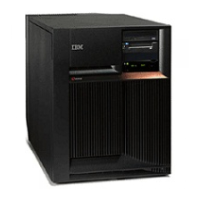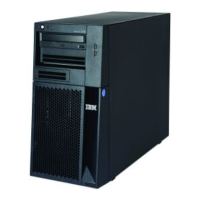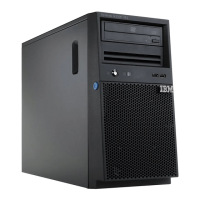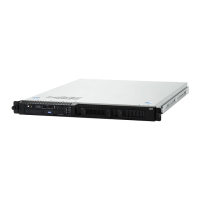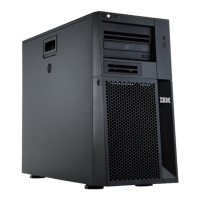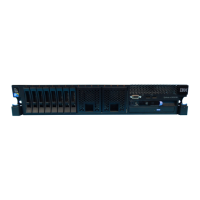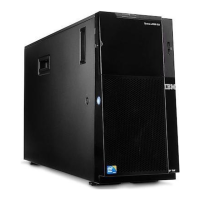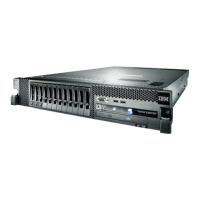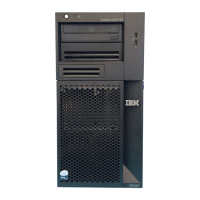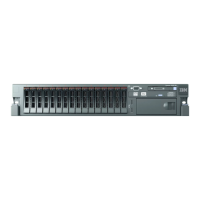Do you have a question about the IBM z13s and is the answer not in the manual?
Introduces the z13s server, its features, and core business functions like data processing and I/O infrastructure.
Reviews key features and functions of z13s servers including processor, memory, I/O, virtualization, and RAS design.
Briefly reviews major elements of z13s servers: models, upgrade paths, frame, CPC drawer, I/O connectivity, subsystem, and Parallel Sysplex coupling.
Discusses HMCs and SEs as appliances providing platform management for z Systems servers, covering enhancements and connectivity.
Describes the zBX Model 004's role in improving infrastructure reliability and managing heterogeneous compute elements in an ensemble.
Explains the integrated management software for ensembles, covering its six management areas like operational controls and hypervisor management.
Introduces DPM as a new administrative mode for Linux-only CPCs, simplifying hardware and virtual infrastructure management.
Lists supported operating systems for z13s servers and discusses software support, including IBM compilers.
Details the z Systems frames as EIA enclosures, describing the components within the z13s central processor complex (CPC) frame.
Explains the z13s CPC drawer structure, including SCMs, memory, connectivity, and fanouts.
Describes the SCM as a multi-layer substrate module holding PU or SC chips, detailing its physical dimensions and transistor count.
Covers memory configurations, including maximum physical memory, RAIM design, DIMM capacities, and memory granularity.
Discusses the RAS strategy and features of z13s servers, focusing on error prevention, detection, recovery, and nondisruptive capabilities.
Explains connections to PCIe I/O drawers, I/O drawers, Parallel Sysplex InfiniBand, and Integrated Coupling Adapters.
Details the available models (N10, N20) and PU characterizations (CP, IFL, ICF, zIIP, SAP), including upgrade paths and concurrent PU conversions.
Addresses environmental concerns, focusing on energy consumption, power considerations, cooling requirements, and power estimation tools.
Provides a summary table of z13s structure aspects, including PU SCMs, CPs, memory sizes, and cache structures.
Provides an evolutionary overview of z13s symmetric multiprocessor (SMP) systems, its RAS features, and design principles.
Highlights the physical packaging differences from zBC12, modular CPC drawer design, and improvements in instruction execution.
Details the CPC drawer structure, memory controllers, cache levels, and the technology used for high-speed, power-efficient circuits.
Explains processor cycle time, design improvements, architectural extensions, and the superscalar processor core with its execution units.
Describes the functions of processor units (PUs) on z13s servers, including characterization and PU pools.
Covers memory subsystem topology, including controllers, DIMMs, and RAIM protection.
Addresses logical partitioning features, including PR/SM, LPAR management, and HiperDispatch.
Introduces IRD for z/OS to optimize processor and channel resource utilization across LPARs.
Discusses Parallel Sysplex as clustering technology for z13 and z13s servers, covering coupling links and CFCC.
Introduces the two types of internal I/O infrastructure: InfiniBand and PCIe-based.
Lists z13s I/O characteristics and supported features, including concurrent upgrades and dynamic I/O configuration.
Describes the I/O drawer's EIA units, I/O feature cards, domains, and connections.
Details the PCIe I/O drawer's attachment to CPC via PCIe bus, its data rate, and the number of supported channels.
Lists PCIe I/O features and offerings, including FICON Express, OSA-Express, and others.
Explains fanout cards for connecting I/O subsystem to CPC drawer, supporting ICA SR and InfiniBand coupling links.
Lists I/O features (cards) with ports for connecting to external devices and networks.
Discusses connectivity options like FICON, OSA-Express, HiperSockets, SMC-R, SMC-D, and Parallel Sysplex.
Covers Parallel Sysplex technology, coupling links, and CFCC, emphasizing reliability and availability.
Addresses concepts of channel subsystem, multiple LCSS, subchannel sets, and technology.
Discusses tools for maintaining and optimizing I/O configuration, including eConfig, HCD, and CMT.
Summarizes z13s channel subsystem features like multiple LCSS, subchannel sets, and channel spanning.
Introduces PCI Crypto Express5S, redesigned CPACF, and CCA/EP11 enhancements for compliance.
Provides a short introduction to cryptography principles, including protection, authentication, integrity, and non-repudiation.
Details cryptographic hardware features like CPACF and Crypto Express5S, specialized for cryptographic workloads.
Explains CPACF's role in accelerating encryption/decryption and its supported functions.
Introduces Crypto Express5S as an optional feature for secure programming and hardware environment for crypto processes.
Describes TKE workstation for key management functions and its hardware/software requirements.
Compares cryptographic functions and attributes supported by CPACF, CEX5C, CEX5P, and CEX5A.
Lists software support levels for cryptographic functions, including z/OS, z/VM, and Linux.
Lists minimum operating system levels required for z13s and zBX Model 004.
Addresses support for z13s functions by current operating systems like z/OS, z/VM, z/VSE, z/TPF, and Linux.
Addresses operating system support by function, covering single system image, cryptographic support, and others.
Details cryptographic support for CPACF and Crypto Express5S, including software requirements.
Summarizes the types of upgrades available for IBM z13s servers, including permanent and temporary options.
Discusses concurrent upgrades for z13s servers, providing extra capacity without server outage.
Covers MES upgrades for processors, memory, I/O, and zBX features for concurrent and permanent capacity growth.
Explains ordering, downloading, and applying permanent and temporary upgrades using the CIU facility.
Details On/Off CoD for temporarily enabling PUs and unassigned IFLs, and managing capacity settings.
Describes CPE offering for replacement backup capacity for planned downtime events, like server room extensions.
Explains CBU for reserved emergency backup capacity for unplanned situations and disaster recovery.
Discusses nondisruptive upgrades for z13s servers, covering concurrent upgrades and avoiding system outages.
Summarizes capacity on-demand (CoD) infrastructure and offerings for z13s servers, emphasizing flexibility and control.
Outlines the RAS strategy focused on improving availability by reducing planned and unplanned outages through new technology.
Details availability characteristics of z13s servers, including concurrent LIC memory upgrades and EDM.
Describes RAS functions addressing unscheduled, scheduled, and planned outages, and dynamic configuration tasks.
Explains EDM for reducing planned outages by supporting concurrent LIC Driver updates.
Covers RAS capabilities of HMC and SE, including backup options, RSF, microcode management, and connectivity.
Details RAS capabilities of zBX Model 004, including hardware redundancy and concurrent operations.
Discusses PowerHA SystemMirror for AIX in zBX environment for high availability and automated failover.
Introduces IBM zAware for real-time diagnostics and monitoring, analyzing system logs for anomalies.
Covers Flash Express RAS capabilities, including pairs installation, RAID configuration, and concurrent firmware upgrades.
Details power and I/O cabling options for z13s servers, including raised floor and non-raised floor installations.
Describes the weights and dimensions of z13s servers, including frame configurations and bolt-down kits.
Provides information on environmental components for zBX, including configurations, power supplies, and cooling.
Covers energy management elements, including power estimation, system activity display, and Unified Resource Manager.
Introduces HMC and SE as stand-alone computers for managing z Systems CPCs, LPARs, and providing support applications.
Details HMC application version 2.13.1 and SE driver level 27 enhancements for z13s servers.
Covers HMC and SE network connectivity using Ethernet LANs, including TCP/IP Version 6 support.
Explains HMC RSF for hardware problem reporting and service, including communication types and security.
Covers key areas of HMC and SE capabilities, including CPC management, LPAR management, and OS communication.
Describes HMC in an ensemble for platform systems management, covering Unified Resource Manager and ensemble topology.
Provides estimated capacity ratios for z13s compared to previous servers and discusses workload type variations.
Explains LSPR capacity tables and software characteristics used for workload identification.
Examines factors affecting workload capacity performance: instruction path length, complexity, and memory hierarchy.
Defines RNI as the level of activity to shared caches and memory, influencing workload performance.
Introduces new workload categories (LOW, AVERAGE, HIGH) based on RNI, similar to past primitives.
Discusses techniques used to match production workloads to LSPR workloads and new z/OS workload categories.
Explains expected performance variations across workloads and the impact of memory and cache designs.
Defines appliance as an integration of OS, middleware, and software components, and introduces the zACI framework.
Explains benefits of zACI frameworks, including reduced team effort and common behaviors for operations.
Details features and advantages of appliances based on zACI framework, including encapsulated OS and remote APIs.
Discusses system anomalies and failures in complex IT environments, and the need for effective problem diagnosis.
Introduces IBM zAware as an expert solution for real-time diagnostics, monitoring, and pattern-based message analysis.
Explains IBM zAware technology, creating a base model of system behavior by accessing system logs.
Details hardware and software requirements for IBM zAware, including features and ordering.
Briefly describes SMC functionality implemented on IBM z Systems servers for efficient data transfer.
Covers RoCE exploitation over zEnterprise, explaining RDMA technology and SMC-R protocol.
Describes SMC-D functions implemented in IBM z13 and z13s servers, including ISM and vPCI adapter concepts.
Introduces DPM as a mode of operation for z Systems servers, simplifying virtualization management.
Explains the target customers and benefits of DPM mode, focusing on cloud infrastructure integration and management ease.
Discusses how IBM z Systems servers are virtualized and how DPM utilizes PR/SM for resource management.
Provides a checklist for setting up the DPM environment, including planning and configuration steps.
Highlights benefits of KVM for IBM z Systems, such as cost-effectiveness, simplicity, and leveraging z Systems platform strengths.
Describes IBM z Systems servers and KVM, including virtualization, storage, and network connectivity.
Explains how to manage KVM environment using OpenStack, virt-manager, or IBM Cloud Manager.
Introduces native PCIe adapter design, including IFP and resource groups, and management tasks.
Details the rules for installing native PCIe adapters, including maximum numbers and combinations.
Explains native PCIe adapter definitions like FUNCTION identifier, Virtual Function ID, and Physical network ID.
Provides an overview of Flash Express, its implementation, and benefits for availability and performance.
Explains how to use Flash Express for z/OS paging, memory dumps, and CF partition assignment.
Covers security aspects of Flash Express, including encryption, key management, and SE/smart card integration.
Provides an overview of GDPS offerings, addressing IT resiliency goals like RPO and RTO.
Discusses GDPS Virtual Appliance as a solution for Linux on z Systems, including its components and positioning.
Presents recovery scenarios for GDPS Virtual Appliance, including planned disk outage, unplanned disk outage, and disaster recovery.
Describes the growth of data and the need for compression, introducing zEDC Express for hardware acceleration.
Details zEDC Express as an optional feature for hardware-based data compression and decompression.
Lists software support for zEDC Express functions, including z/OS and Linux distributions.
| RAIM | Redundant Array of Independent Memory |
|---|---|
| Architecture | z/Architecture |
| Processor | IBM z13 |
| Number of Processors | Up to 2 |
| Networking | OSA-Express, RoCE Express |
| Security Features | IBM Secure Service Container |
| Clock Speed | 5 GHz |
| Max LPARs | 85 |
| Operating Systems | z/OS, z/VM, z/VSE, Linux on IBM Z |
| Form Factor | 19-inch rack-mounted |
